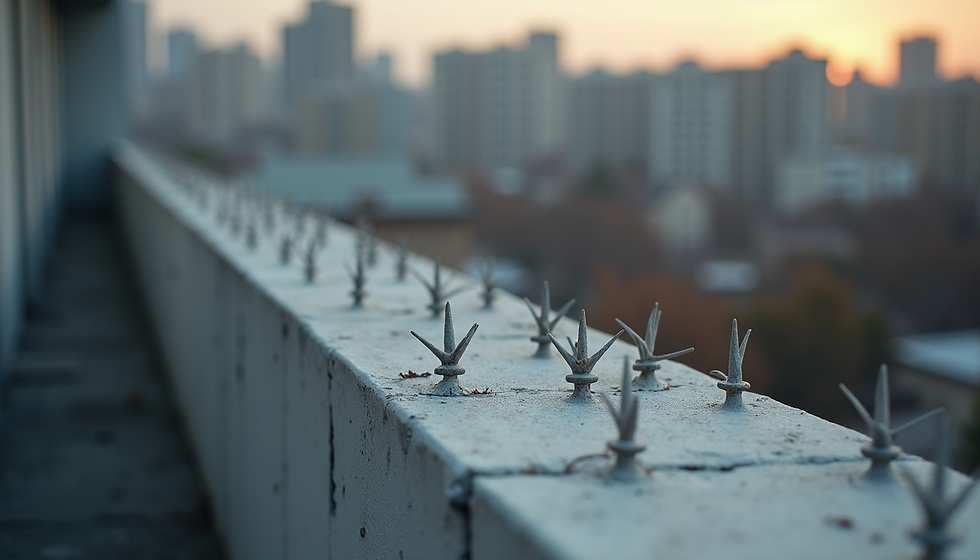Effective Bird Proofing Solutions for Your Home
- NFZblog
- May 13
- 4 min read
Birds can be a beautiful part of nature, but when they decide to make your home their playground, it can lead to a host of problems. From unsightly droppings to potential damage, birds can create a nuisance that many homeowners want to avoid. Fortunately, there are effective bird proofing solutions that can help keep your home safe and clean. In this post, we will explore various methods to deter birds from nesting or roosting around your property.
Birds are attracted to homes for several reasons. They may find shelter, food, or a safe place to raise their young. Understanding why birds are drawn to your home is the first step in preventing them from becoming a problem.
Understanding the Problem
Before implementing bird proofing solutions, it is essential to understand the types of birds that may invade your space. Common culprits include pigeons, sparrows, and starlings. These birds often seek out ledges, eaves, and other sheltered areas to nest.
Bird droppings can damage your home’s exterior and create health hazards. They can corrode paint, damage roofing materials, and even lead to structural issues over time.
Why Bird Proofing is Important
Bird proofing is not just about aesthetics; it is about protecting your home and health. Bird droppings can carry diseases, and their nesting materials can clog gutters and drains. By taking proactive measures, you can avoid costly repairs and maintain a clean living environment.
Effective Bird Proofing Solutions
Now that we understand the problem, let’s explore some effective bird proofing solutions.
1. Physical Barriers
One of the most effective ways to deter birds is by using physical barriers. These can include:
Bird Spikes: These are plastic or metal spikes that can be installed on ledges, rooftops, and other surfaces where birds like to perch. They prevent birds from landing without causing them harm.
Bird Netting: This is a mesh material that can be used to cover areas where birds are likely to nest. It is effective for larger spaces, such as balconies or patios.
Wire Mesh: Similar to bird netting, wire mesh can be used to block entry points. It is durable and can be shaped to fit various areas.
2. Visual Deterrents
Birds can be easily scared away by visual deterrents. Here are some options:
Reflective Objects: Hanging reflective tape, old CDs, or aluminum foil can create a shimmering effect that confuses and scares birds away.
Decoys: Placing decoys of predatory birds, such as owls or hawks, can deter smaller birds from approaching. Make sure to move the decoys regularly to maintain their effectiveness.
3. Sound Deterrents
Sound can also be an effective way to keep birds at bay. Consider these options:
Ultrasonic Devices: These devices emit high-frequency sounds that are unpleasant to birds but inaudible to humans. They can be effective in keeping birds away from specific areas.
Noise Makers: Wind chimes or other noise-making devices can create sounds that may scare birds off.
4. Chemical Deterrents
While not always the first choice, chemical deterrents can be effective in certain situations.
Bird Repellent Gel: This sticky substance can be applied to surfaces where birds like to perch. It makes the surface uncomfortable for birds without causing them harm.
Taste Aversion Products: These products can be sprayed on surfaces to make them taste unpleasant to birds.
5. Habitat Modification
Sometimes, the best solution is to modify the environment to make it less appealing to birds.
Remove Food Sources: Ensure that trash cans are sealed and that pet food is not left outside.
Trim Trees and Shrubs: Keeping trees and shrubs well-trimmed can reduce nesting opportunities.
Seal Entry Points: Inspect your home for any gaps or holes where birds could enter. Sealing these areas can prevent birds from nesting.
Maintenance and Monitoring
Once you have implemented bird proofing solutions, it is essential to monitor their effectiveness. Regularly check for signs of bird activity and make adjustments as needed.
Regular Cleaning
Keeping your property clean is crucial. Regularly clean areas where birds may have left droppings or nesting materials. This not only helps maintain your home’s appearance but also reduces health risks.
Seasonal Considerations
Bird activity can vary by season. Be especially vigilant during spring and summer when birds are nesting. Adjust your bird proofing strategies as needed to ensure continued effectiveness.
When to Seek Professional Help
If you find that your bird proofing efforts are not working, it may be time to seek professional help. Pest control experts can assess your situation and recommend tailored solutions.
Choosing the Right Professional
When selecting a pest control service, look for one that specializes in bird control. They should have experience with various bird species and be knowledgeable about humane methods of deterrence.
Final Thoughts
Bird proofing your home is an essential step in maintaining a clean and safe environment. By understanding the problem and implementing effective solutions, you can deter birds from making your home their own.
Whether you choose physical barriers, visual deterrents, or habitat modifications, the key is to be proactive. Regular maintenance and monitoring will ensure that your efforts remain effective over time.
With the right approach, you can enjoy the beauty of birds from a distance while keeping your home free from their unwanted presence.

By taking these steps, you can protect your home and enjoy peace of mind. Remember, a little effort goes a long way in keeping your living space bird-free.










Comments